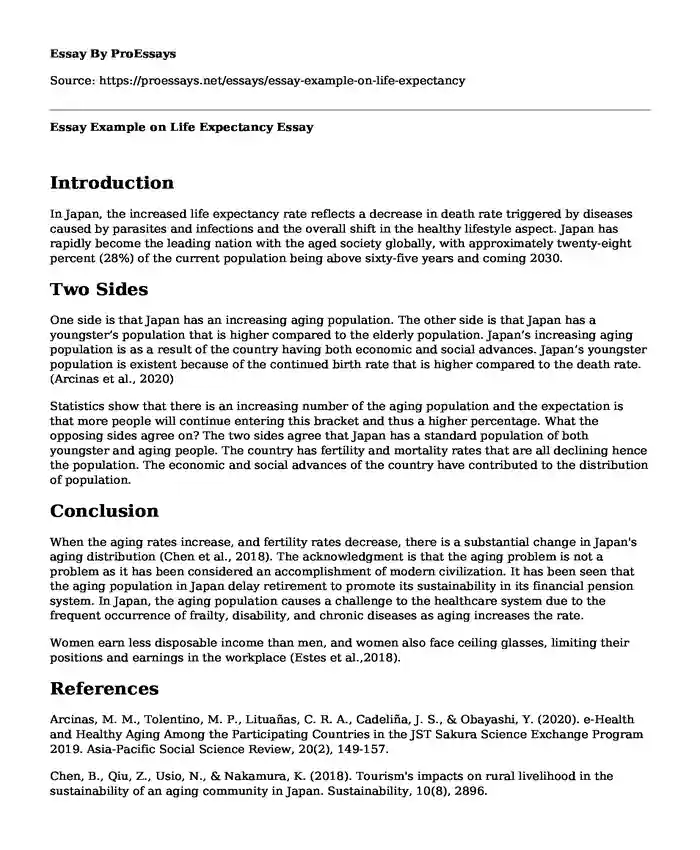Introduction
In Japan, the increased life expectancy rate reflects a decrease in death rate triggered by diseases caused by parasites and infections and the overall shift in the healthy lifestyle aspect. Japan has rapidly become the leading nation with the aged society globally, with approximately twenty-eight percent (28%) of the current population being above sixty-five years and coming 2030.
Two Sides
One side is that Japan has an increasing aging population. The other side is that Japan has a youngster’s population that is higher compared to the elderly population. Japan’s increasing aging population is as a result of the country having both economic and social advances. Japan’s youngster population is existent because of the continued birth rate that is higher compared to the death rate. (Arcinas et al., 2020)
Statistics show that there is an increasing number of the aging population and the expectation is that more people will continue entering this bracket and thus a higher percentage. What the opposing sides agree on? The two sides agree that Japan has a standard population of both youngster and aging people. The country has fertility and mortality rates that are all declining hence the population. The economic and social advances of the country have contributed to the distribution of population.
Conclusion
When the aging rates increase, and fertility rates decrease, there is a substantial change in Japan's aging distribution (Chen et al., 2018). The acknowledgment is that the aging problem is not a problem as it has been considered an accomplishment of modern civilization. It has been seen that the aging population in Japan delay retirement to promote its sustainability in its financial pension system. In Japan, the aging population causes a challenge to the healthcare system due to the frequent occurrence of frailty, disability, and chronic diseases as aging increases the rate.
Women earn less disposable income than men, and women also face ceiling glasses, limiting their positions and earnings in the workplace (Estes et al.,2018).
References
Arcinas, M. M., Tolentino, M. P., Lituañas, C. R. A., Cadeliña, J. S., & Obayashi, Y. (2020). e-Health and Healthy Aging Among the Participating Countries in the JST Sakura Science Exchange Program 2019. Asia-Pacific Social Science Review, 20(2), 149-157.
Chen, B., Qiu, Z., Usio, N., & Nakamura, K. (2018). Tourism's impacts on rural livelihood in the sustainability of an aging community in Japan. Sustainability, 10(8), 2896.
https://doi.org/10.3390/su10082896
Estes, C., Anstee, Q. M., Arias-Lost, M. T., Bantel, H., Bellentani, S., Caballeria, J., ... & Eguchi, Y. (2018). Modeling NAFLD disease burden in China, France, Germany, Italy, Japan, Spain, the united kingdom, and the united states for 2016–2030. Journal of hepatology, 69(4), 896-904.
https://doi.org/10.1016/j.jhep.2018.05.036.
Cite this page
Essay Example on Life Expectancy. (2024, Jan 06). Retrieved from https://proessays.net/essays/essay-example-on-life-expectancy
If you are the original author of this essay and no longer wish to have it published on the ProEssays website, please click below to request its removal:
- 2002 Homeland Security Act Essay Example
- Why Boys Should Go to Engineering Schools, Why Girls Should Go to Nursing?
- Eliminating Gender Bias in the Workplace Paper Example
- Movie Analysis Essay on Wonder Woman
- Essay on the Power of Women: Achieving Sustainable Development Through Gender Equality
- Impacts of Violence, Poverty and HIV Infection on African American Transgender Females - Essay Sample
- Muslims in Western Democracies: Pluralism Tested - Essay Sample







